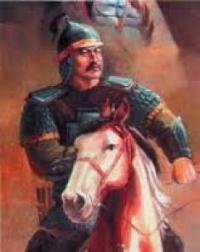You are here
Nauryzbay batyr (1706 - 1781).

Sightseeing tours in Kazakhstan.
“Immortality bestows glory
And striving for good deeds,
But flattery is in the mouth of her poison,
That valor in the seeds will die "
Vasily Kapnist.
Student Tour in Kazakhstan.
Nauryzbay Kuttymbetuly is the hero of the war against the Dzungars, one of the three standard bearers (Kabanbay, Bogenbay, Nauryzbay) Abylay Khan, the commander is the head of Tumen, the 10,000th army.
He was born in the area of Zhalpaktas-Seriktas (the current territory of the Zhambyl district of Atmatinskaya oblast) in 1706, and came from the genus of the tolemis of the tribal union of Shaprashta. The whole life of Nauryzbay batyr passed in wars with the Dzungars.
The heyday of his military and social activities occurred in the 30-40s of the XVIII century. The victories of Nauryzbay in 1729 in fights with Shamal Khan and Kaskelen were known throughout the Kazakh steppe. In 1750-1752, he, along with the Batyrs Malaysary, Kystyk Malay and Shaprashty Kaskary, defeated the Dzungars, dropping them behind Turpan (the present territory of the PRC) and freeing many Kazakhs from captivity. In the Dzungarian wars, three brothers of Nauryzbay - Kudaibergen, Sholpan and Duisen were killed.
In 1723, Nauryzbay was seventeen years old. As always, during the years of warfare (Years of Great Disaster), children begin to grow up quickly. So Nauryzbay with his brothers (there were five of them), participating in campaigns, relocations, bearing all the hardships of the war, became a prominent person in a short time.
Nauryzbay was a tall and large boy. His heroic gain was favorably emphasized by high growth. Father, a wealthy man, noting that his son has a strong physique since childhood, specially raised two pinto foals, instead of water he watered them with cow's milk.
These two pinto horses served Nauryzbay for eighteen years. On one of them, he went to the first battle with the Dzungars, increasing the glory of his people. In the spring of 1729 the number of the Kazakh army was more than thirty thousand people.
Two tumens were led by Karakerey Kabanbai and Kanzhigaly Bogenbai, and the famous Batyrs Dulat Otegen and Shaprashty Kazybek took command of the unit exposed by the Senior Zhuz. After the battle in the Uzunbulak area, in the Karatau mountains, Otegen Batyr went missing; leadership of the troops of the Senior Zhuz passed to Kazybek Batyr.
The people, gradually rallying, began to clearly feel their increasing power day by day. Proof of this was the victory in the largest battle of Anirakai, after which the Kazakh-Dzungarian confrontation waned. But after some time, disturbing news came that the Dzungarian khan Shamal with his chief military commander Kaskelen was again gathering troops near the town of Ush (Ush - Almaty), preparing for new battles. Shaprashty Kazybek batyr came to the decision that whoever enters the duel with Shamal Khan and Kaskelen will lead the army of the Elder Zhuz.
Shamal and Kaskelen, not yet thirty years old, were people of great physical strength, capable of "tearing iron with their hands." The general was elected Nauryzbay, who led the army to the city of Ush. Shamal became aware of the movement of the Kazakh army.
He, too, was preparing for war, was about to put on a duel his famous warriors, such as Dombai, Boraldai, Kangyr and others. But he placed especially high hopes on Kaskelen, who grew up among the Kazakhs and knew the strengths and weaknesses of their martial art.
But the duel between Nauryzbay batyr and Kaskelen did not last long. Almost immediately, Nauryzbay’s spear pierced through the enemy. The glory of the batyr spread far across the steppe. He became the commander of Tumen and received the name Shaprashty Nauryzbay batyr, thereby earning the name of the great warrior and commander.
At the end of November, Shaprashty Nauryzbay, arriving in Dabyl and Nugara, gathered the remnants of the army, which was on a respite. Shamal Khan was well aware of this. His army totaled up to ten thousand sabers.
Located at the mouth of the Naryn River, by the lake Balkhash, the Dzungars were fishing, robbing Kazakh villages and rallying forces. With the onset of spring, Shamal Khan moved his troops south and settled down in eight places along the Nura River and around Middle Bakanas.
Nauryzbay’s army was located on the shore of Ainakol. The battle began immediately. Kangyr, Mandabar, Dombail came to the first fight, they were struck by Senkibay, Shoibek, Mambet. Willingly or not, Khan Shamal himself had to go out to the duel.
Toward him, the head of the tumen, Nauryzbay, spoke. Nauryzbay turned out to have more strength, and from the very first blow, he dumped Shamal with a brush. The “decapitated” Dzhungars tried to surround Nauryzbay, but the Kazakhs launched an attack with the cry “Bakhtiyar!” The Dzhungars were driven into the sands of Bestas, where many of them remained forever. Ainakol since then began to be called Nauryzbaykol, and the place of battle was called the Maidan.
These were the first battles after the appointment of Shaprashty Nauryzbay as the head of Tumen - March. Subsequently, the batyr did not let go of arms until he was seventy years old. He remained a commander under Abylai Khan and was considered one of the main batyrs until the complete liberation of the Kazakh lands from the Dzungarian invaders.
Authority:
http://www.tarih.spring.kz/en/history/medieval/figures/nauryzbai/







